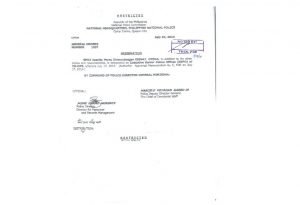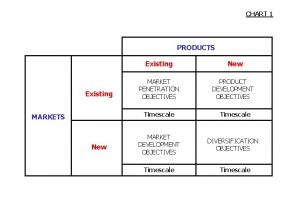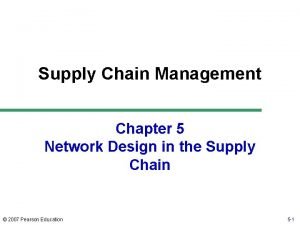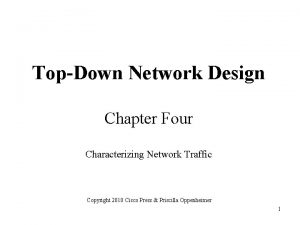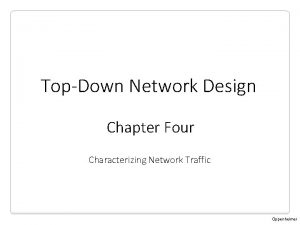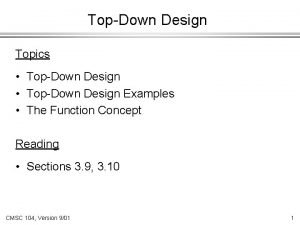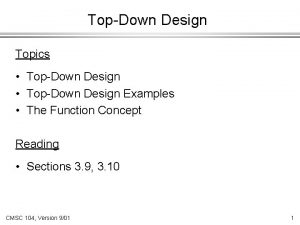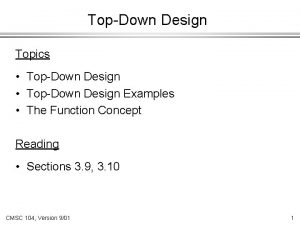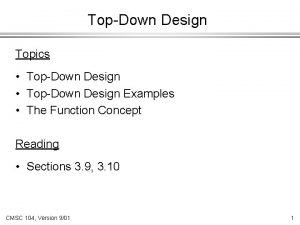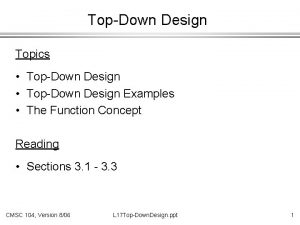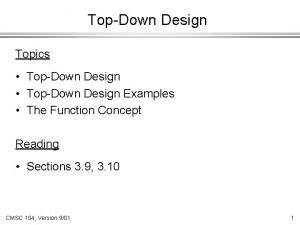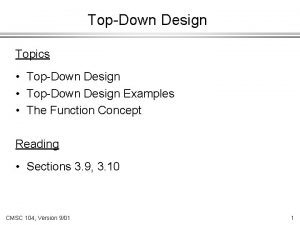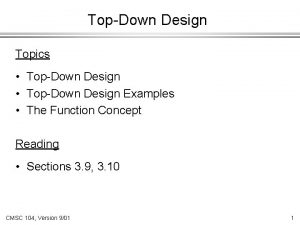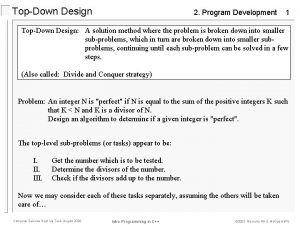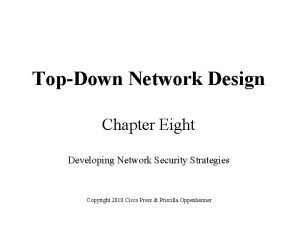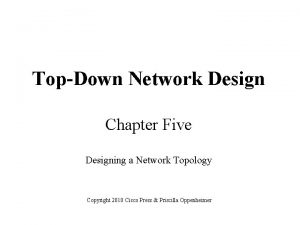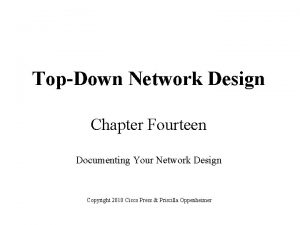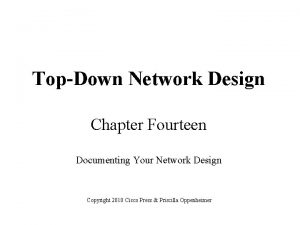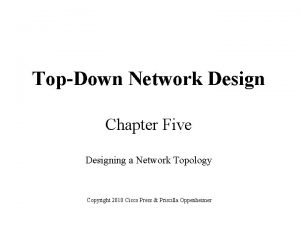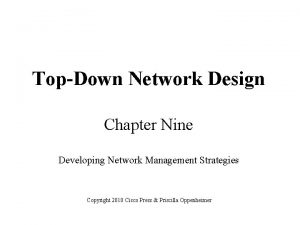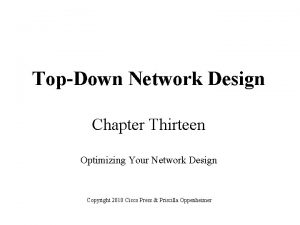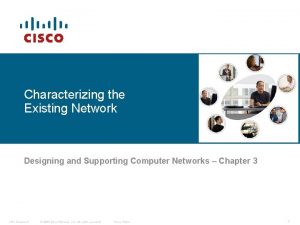TopDown Network Design Chapter Three Characterizing the Existing






















- Slides: 22

Top-Down Network Design Chapter Three Characterizing the Existing Internetwork Copyright 2010 Cisco Press & Priscilla Oppenheimer 1

What’s the Starting Point? • According to Abraham Lincoln: – “If we could first know where we are and whither we are tending, we could better judge what to do and how to do it. ” 2

Where Are We? • Characterize the existing internetwork in terms of: – Its infrastructure • Logical structure (modularity, hierarchy, topology) • Physical structure – Addressing and naming – Wiring and media – Architectural and environmental constraints – Health 3

Get a Network Map Medford Fast Ethernet 50 users Roseburg Fast Ethernet 30 users Frame Relay CIR = 56 Kbps DLCI = 5 Frame Relay CIR = 56 Kbps DLCI = 4 Grants Pass HQ Gigabit Ethernet Grants Pass HQ Fast Ethernet 75 users FEP (Front End Processor) IBM Mainframe T 1 Web/FTP server Eugene Ethernet 20 users T 1 Internet 4

Characterize Addressing and Naming • IP addressing for major devices, client networks, server networks, and so on • Any addressing oddities, such as discontiguous subnets? • Any strategies for addressing and naming? – For example, sites may be named using airport codes • San Francisco = SFO, Oakland = OAK 5

Discontiguous Subnets Area 0 Network 192. 168. 49. 0 Router A Area 1 Subnets 10. 108. 16. 0 10. 108. 31. 0 Router B Area 2 Subnets 10. 108. 32. 0 10. 108. 47. 0 6

Characterize the Wiring and Media • • • Single-mode fiber Multi-mode fiber Shielded twisted pair (STP) copper Unshielded-twisted-pair (UTP) copper Coaxial cable Microwave Laser Radio Infra-red 7

Campus Network Wiring Horizontal Wiring Work-Area Wiring Wallplate Telecommunications Wiring Closet Vertical Wiring (Building Backbone) Main Cross-Connect Room (or Main Distribution Frame) Building A - Headquarters Intermediate Cross-Connect Room (or Intermediate Distribution Frame) Campus Backbone Building B 8

Architectural Constraints • Make sure the following are sufficient – Air conditioning – Heating – Ventilation – Power – Protection from electromagnetic interference – Doors that can lock 9

Architectural Constraints • Make sure there’s space for: – Cabling conduits – Patch panels – Equipment racks – Work areas for technicians installing and troubleshooting equipment 10

Issues for Wireless Installations • • Reflection Absorption Refraction Diffraction 11

Check the Health of the Existing Internetwork • • Performance Availability Bandwidth utilization Accuracy Efficiency Response time Status of major routers, switches, and firewalls 12

Characterize Availability MTBF MTTR Date and Duration of Last Major Downtime Cause of Last Major Downtime Fix for Last Major Downtime Enterprise Segment 1 Segment 2 Segment n 13

Network Utilization in Minute Intervals 14

Network Utilization in Hour Intervals 15

Bandwidth Utilization by Protocol Relative Network Utilization Absolute Network Utilization Broadcast Rate Multicast Rate Protocol 1 Protocol 2 Protocol 3 Protocol n 16

Characterize Packet Sizes 17

Characterize Response Time Node A Node B Node C Node D X X 18

Check the Status of Major Routers, Switches, and Firewalls • • show buffers show environment show interfaces show memory show processes show running-config show version 19

Tools • • • Protocol analyzers Multi Router Traffic Grapher (MRTG) Remote monitoring (RMON) probes Cisco Discovery Protocol (CDP) Cisco IOS Net. Flow technology Cisco. Works 20

Summary • Characterize the existing internetwork before designing enhancements • Helps you verify that a customer’s design goals are realistic • Helps you locate where new equipment will go • Helps you cover yourself if the new network has problems due to unresolved problems in the old network 21

Review Questions • What factors will help you decide if the existing internetwork is in good enough shape to support new enhancements? • When considering protocol behavior, what is the difference between relative network utilization and absolute network utilization? • Why should you characterize the logical structure of an internetwork and not just the physical structure? • What architectural and environmental factors should you consider for a new wireless installation? 22
 Top-down processing
Top-down processing Characterizing schedules based on recoverability
Characterizing schedules based on recoverability Characterizing schedules based on serializability
Characterizing schedules based on serializability Characterizing schedules based on serializability
Characterizing schedules based on serializability Refactoring improving the design of existing code
Refactoring improving the design of existing code Ece 526
Ece 526 Defects of secondary education commission 1952-53
Defects of secondary education commission 1952-53 The similarity of ending sounds existing between two words
The similarity of ending sounds existing between two words Fitness center use case diagram for gym management system
Fitness center use case diagram for gym management system Cima practical experience requirements
Cima practical experience requirements Living not existing
Living not existing Hipaa pre-existing condition protections
Hipaa pre-existing condition protections Pnp organizational structure and their functions
Pnp organizational structure and their functions Existing market adalah
Existing market adalah American society of mechanical engineers
American society of mechanical engineers How securities are traded
How securities are traded Network design in the supply chain chapter 5
Network design in the supply chain chapter 5 Hình ảnh bộ gõ cơ thể búng tay
Hình ảnh bộ gõ cơ thể búng tay Ng-html
Ng-html Bổ thể
Bổ thể Tỉ lệ cơ thể trẻ em
Tỉ lệ cơ thể trẻ em Voi kéo gỗ như thế nào
Voi kéo gỗ như thế nào Tư thế worm breton
Tư thế worm breton












